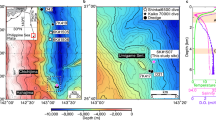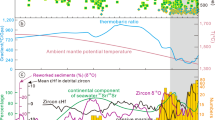Abstract
Most gabbroic cumulates found at ocean spreading centres are thought to have been generated by the fractional crystallization of melts with the composition of mid-ocean ridge basalt (MORB)1. There are exceptions, however, including some cumulates which appear to have come from melts that contain more silica than MORB and are much more depleted in the incompatible elements (those elements that do not readily substitute into the main mineral phases)2. These unusual rocks bear witness to relatively deep petrological processes that are not accessible through the study of melts erupted on the sea floor, and their origin is still debated. Fortunately, the same lithologies can be studied in detail in ophiolites (sections of oceanic crust accreted to a continent). In a fossil mantle diapir of the Oman ophiolite3,4, we have observed the same dichotomy between a suite of ‘normal’, MORB-type, cumulates (‘N-cumulates’) and a suite of cumulates issued from silica-enriched but incompatible-element-depleted melts (‘D-cumulates’). While the N-cumulates crystallized inside the diapir, the D-cumulates occur essentially as intrusions surrounding the diapir. The combination of silica enrichment, extreme depletion in incompatible elements, and seawater isotopic signature indicates that the D-cumulates were formed by the remelting at low pressure of hydrated residual peridotites left after MORB extraction at the ridge axis. The distribution of the D-cumulates relative to the N-cumulates suggests that such depleted melts are produced episodically at ridge axes when the lithospheric mantle is reheated by a new diapiric pulse.
This is a preview of subscription content, access via your institution
Access options
Subscribe to this journal
Receive 51 print issues and online access
$199.00 per year
only $3.90 per issue
Buy this article
- Purchase on Springer Link
- Instant access to full article PDF
Prices may be subject to local taxes which are calculated during checkout




Similar content being viewed by others
References
Dick,H. J. B., Robinson,P. T. & Meyer, P. S. The plutonic foundation of a slow-spreading ridge. American Geophysical Union monograph 70, 1–39 (1992).
Ross,K. & Elthon,D. Cumulates from strongly depleted mid-ocean-ridge basalt. Nature 365, 826– 829 (1993).
Ceuleneer,G., Monnereau,M. & Amri,I. Thermal structure of a fossil mantle diapir inferred from the distribution of mafic cumulates. Nature 379, 149–153 (1996).
Benoit,M., Polvé,M. & Ceuleneer, G. Trace element and isotopic characterization of mafic cumulates in a fossil mantle diapir (Oman ophiolite). Chem. Geol. 134, 199–214 ( 1996).
Grove,T. L., Kinzler,R. J. & Bryan, W. B. in Mantle Flow and Melt Generation at Mid-ocean Ridges (eds Phipps Morgan, J., Blackman, D. K. & Sinton, J. M.) 281–310 (AGU Geophysical Monographs, 71, 1992).
Ross,K. & Elthon,D. Cumulus and postcumulus crystallization in the oceanic crust; major- and trace-element geochemistry of Leg 153 gabbroic rocks. ODP Sci. Res. 153, 333– 350 (1997).
Elthon,D. Mineral chemistry of gabbroic rocks from the Mid-Cayman Rise spreading center. J. Geophys. Res. 92, 658– 682 (1987).
Amri,I., Benoit,M. & Ceuleneer, G. Tectonic setting for the genesis of oceanic plagiogranites: evidence from a paleo-spreading structure in the Oman ophiolite. Earth Planet. Sci. Lett. 139, 177– 194 (1996).
Kelemen,P. Reaction between ultramafic rock and fractionating basaltic magma 1. Phase relations, the origin of calc-alkaline magma series, and the formation of discordant dunite. J. Petrol. 31, 51– 98 (1990).
McCulloch,M. T., Gregory,R. T., Wasserburg, G. J. & Taylor,H. P. Jr . Sm-Nd, Rb-Sr, and 18O/16O isotopic systematics in an oceanic crustal section: evidence from the Samail ophiolite. J. Geophys. Res. 86, 2721– 2735 (1981).
Noiret,G., Montigny,R. & Allègre, C. J. Is the Vourinos complex an island arc ophiolite? Earth Planet. Sci. Lett. 56, 375– 386 (1981).
Dickson Spulber,S. & Rutherford,M. J. The origin of rhyolite and plagiogranite in oceanic crust: an experimental study. J. Petrol. 24, 1–25 ( 1983).
McCulloch,M. T. & Gamble,J. A. Geochemical and geodynamical constraints on subduction zone magmatism. Earth Planet. Sci. Lett. 102, 358–374 (1991).
Meyer,P. S. & Shibata,T. Complex zoning in plagioclase feldspars from ODP site 648. ODP Sci. Res. 106/109, 123–142 (1990).
Sobolev,A. V. & Shimizu,N. Ultra-depleted primary melt included in an olivine from the Mid-Atlantic Ridge. Nature 363 , 151–154 (1993).
Cannat,M. Emplacement of mantle rocks in the seafloor at mid-ocean ridges. J. Geophys. Res. 98, 4163–4172 (1993).
Gente,P. et al. Characteristics and evolution of the segmentation of the Mid-Atlantic ridge between 20° N and 24° N during the last 10 Myr. Earth Planet. Sci. Lett. 129, 55– 71 (1995).
Linn,J., Purdy,G. M., Shouten,H., Sempere,J-C. & Zervas, C. J. Evidence from gravity data for focused magmatic accretion along the mid-Atlantic ridge. Nature 344, 627–632 (1990).
Willie,P. J. Magma genesis, plate tectonics and chemical differentiation of the Earth. Rev. Geophys. 26, 370– 404 (1988).
Irving,A. J. A review of experimental studies of crystal/liquid trace element partitioning. Geochim. Cosmochim. Acta 42, 743– 770 (1978).
Irving,A. J. & Frey,F. A. Trace element abundances in megacrysts and their host basalts: constraints on partition coefficients and megacryst genesis. Geochim. Cosmochim. Acta 48, 1201 –1221 (1984).
McKenzie,D. & O'Nions,R. K. Partial melt distributions from inversion of rare earth element concentrations. J. Petrol. 32, 1021–1091 (1991).
Hart,S. T. & Dunn,T. Experimental cpx/melt partitioning of 24 trace elements. Contrib. Mineral. Petrol. 113, 1–8 (1993).
Bédard,J. H. A procedure for calculating the equilibrium distribution of trace elements among the minerals of cumulate rocks, and the concentration of trace elements in the coexisting liquids. Chem. Geol. 118, 143–153 (1994).
Snow,J. E., Hart,S. R. & Dick,H. J. B. Nd and Sr isotope evidence linking mid-ocean-ridge basalts and abyssal peridotites. Nature 371, 57– 60 (1994).
Nakamura,N. Determination of REE, Ba, Mg, Na and K in carbonaceous and ordinary chondrites. Geochim. Cosmochim. Acta 38, 757– 775 (1974).
Acknowledgements
Field work in Oman was conducted from 1992 to 1995, and was made possible thanks to facilities provided by the Ministry of Petroleum and Minerals of the Sultanate. We thank H. Al Azri for his constant support. Financial support was provided by the Centre National de la Recherche Scientifique in the frame of the “Dynamique et Bilan de la Terre” and “DORSALE” programs. We thank P. Kelemen for his invitation to perform ion probe analyses in Woods Hole. We thank P. Kelemen, B. Dupré, M. Monnereau and M. Rabinowicz for discussions. Many thanks also to the technical staff of Toulouse and Brest for help during data acquisition: M. Valladon (chemistry), P. Brunet and C. Bassoullet (mass spectrometry), B. Reynier (ICP-MS), P. de Parceval (microprobe), A.-M. Roquet (thin sections). We also thank M. Puel-Benoit for hand-picking fresh sample chips.
Author information
Authors and Affiliations
Corresponding author
Rights and permissions
About this article
Cite this article
Benoit, M., Ceuleneer, G. & Polvé, M. The remelting of hydrothermally altered peridotite at mid-ocean ridges by intruding mantle diapirs. Nature 402, 514–518 (1999). https://doi.org/10.1038/990073
Received:
Accepted:
Issue Date:
DOI: https://doi.org/10.1038/990073
This article is cited by
-
Experimental diopsidite: Implications for natural diopsidite genesis through fluid-melt-mantle peridotite reaction
Mineralogy and Petrology (2021)
-
The contrasting geochemical message from the New Caledonia gabbronorites: insights on depletion and contamination processes of the sub-arc mantle in a nascent arc setting
Contributions to Mineralogy and Petrology (2018)
-
The role and conditions of second-stage mantle melting in the generation of low-Ti tholeiites and boninites: the case of the Manihiki Plateau and the Troodos ophiolite
Contributions to Mineralogy and Petrology (2017)
-
Constraints on the magmatic evolution of the oceanic crust from plagiogranite intrusions in the Oman ophiolite
Contributions to Mineralogy and Petrology (2016)
-
A young source for the Hawaiian plume
Nature (2011)
Comments
By submitting a comment you agree to abide by our Terms and Community Guidelines. If you find something abusive or that does not comply with our terms or guidelines please flag it as inappropriate.



